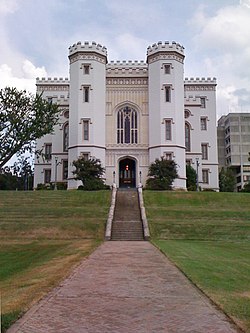Old Louisiana State Capitol
|
Louisiana's Old State Capitol
|
|

Louisiana's Old State Capitol, 2009
|
|
| Location | 100 North Blvd., Baton Rouge, Louisiana, United States |
|---|---|
| Coordinates | 30°26′47.96″N 91°11′19.01″W / 30.4466556°N 91.1886139°WCoordinates: 30°26′47.96″N 91°11′19.01″W / 30.4466556°N 91.1886139°W |
| Area | 4.6 acres (1.9 ha) |
| Built | 1847–1852 |
| Architect | Dakin,James H.; Freret,William A. |
| Architectural style | Gothic Revival |
| NRHP Reference # | 73000862 |
| Significant dates | |
| Added to NRHP | January 12, 1973 |
| Designated NHL | May 30, 1974 |
The Louisiana's Old State Capitol is a historic government building, and now a museum, at 100 North Boulevard in Baton Rouge, Louisiana, U.S.A.. Built in which housed the Louisiana State Legislature from the mid-19th century until the current capitol tower building was constructed in 1929-32.
It was built to both look like and function like a castle and has led some locals to call it the Louisiana Castle, the Castle of Baton Rouge, the Castle on the River, or the Museum of Political History; although most people just call it the old capitol building. The term "Old State Capitol" in Louisiana is used to refer to the building and not to the two towns that were formerly the capital city: New Orleans and Donaldsonville. It was designated a National Historic Landmark in 1974 for its architecture.
In 1846, the state legislature in New Orleans decided to move the seat of government to Baton Rouge. As in many states, representatives from other parts of Louisiana feared a concentration of power in the state's largest city. In 1840, New Orleans' population was about 102,000, fourth-largest city in the U.S. The 1840 population of Baton Rouge, on the other hand, was only 2,269.
On September 21, 1847, the city of Baton Rouge donated to the state of Louisiana a $20,000 parcel of land for a state capitol building. The land donated by the city for the capitol stands high atop a bluff facing the Mississippi River, a site that some believe was once marked by the red pole, or le baton rouge, which French explorers claimed designated a Native American council meeting site.
New York architect James H. Dakin was hired to design the Baton Rouge capitol building, and rather than mimic the national Capitol Building in Washington, as so many other states had done, he conceived a Neo-Gothic medieval-style castle overlooking the Mississippi. Dakin referred to his turreted design, built 1847-52, as "Castellated Gothic" due to its decoration with cast iron, which was both cheaper and more durable than other building materials used at the time.
...
Wikipedia


